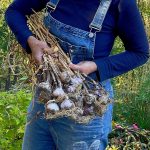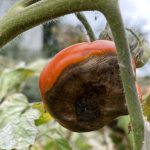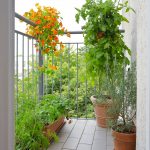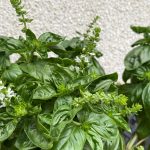How do you decide which plants to grow in the same space? Vegetable companion planting can be tricky, and you want to make sure you plant compatible plants together (as some plants are competitive with one another). However, true companion planting is more than just ensuring the plants won’t work against each other.
In indigenous horticulture many, many years ago, beans, corn, and squash were all planted in the same mound. This came to be known as ‘the three sisters’. Each plant type grew in a symbiotic relationship as the corn provided stalks for the beans to grow, the squash provided ground cover and weed control, and the beans provided nitrogen for the corn and squash. This is the original form of companion planting.
You could say that companion planting is more of an art than it is a science and it has been practised for centuries. The data that has been collected over the years supporting companion planting has been more anecdotal than purely scientific because to singly isolate companion factors from one plant to another is very hard to create or measure. What causes plants to grow is complex and multiple factors affect growth in a dynamic way all during the growing season.
In this blog, let’s define companion planting, look at the advantages of companion planting, and examine the chart on companion planting.
What is Companion Planting?
Companion planting is a system of pairing plants together that mutually benefit each other. The benefits are far ranging like:
- It could be that one plant protects another from various insects or diseases.
- Some plants fix nitrogen in the soil to promote the growth of a heavy feeding plant.
- One plant could act as a shade or trellis for another.
On the other side of the coin, some plants are know to be bad neighbours where they actually are detrimental to the growth of another by:
- Attracting insects and diseases to the area.
- Blocking out sunlight to another plant.
- Both plant types feed on the same nutrients, causing injury to one another.
As mentioned earlier, the practice of companion planting is more of an art than it is a science, but don’t let this stop you from trying out the combinations listed in the chart below.
The Advantages of Companion Planting
Companion Planting Helps Reduce Bugs & Diseases
Certain groups or families of plants share common bugs and diseases. When plants from the same families are grouped together in a garden, they exacerbate the pathology with each other.
- A Negative Companion Planting Relationship:
- For example, both tomatoes and potatoes are from the Solanaceae family, commonly called the Nightshade family. They are susceptible to the same blights (fungal diseases). It’s always recommended that they are grown far apart from one another so that they don’t worsen or pass blights to one another.
- Some Positive Companion Planting Relationships:
- Rosemary & Mint help deter cabbage moth in Cole Crops (Broccoli, Brussels Sprouts, Cabbage, Cauliflower, Kale)
- Garlic helps improve flavour in Cole Crops
- Mint helps repel slugs in leaf crops like lettuce, spinach, swiss chard
- Marigolds are commonly used in vegetable gardens as they are seen to be beneficial for deterring many garden pests like beetles and nematodes which damage root crops.
- Trap Crops are a type of Companion Planting. Trap crops work by attracting a certain kind of bug to a particular plant to keep it away from other plants. For example, Aphids love Lupines. If you plant Lupines in your garden, the aphids will go to the Lupines before they will go to another plant they are attracted to, but not as much as Lupines. The Lupines will help to keep the aphids away from other plants, like Geraniums.
Companion Planting Helps to Provide Natural Supports
In companion planting, plants work together. Companion planting can provide trellises or supports to climbing and vining crops in a natural way. Taller plants like corn and sunflowers, can act as a trellis for beans, peas, and cucumbers.
Companion Planting Helps with Weed Control
Weeds have been an issue for gardens since people became gardeners. Mulch helps with weeds, but low growing plants (called cover crops) like mint, thyme, strawberries, and cucumbers can act as live mulches by helping to choke out weeds with their thick mat of leaves. This mat reduces sunlight to weeds and weakens them.
You will still need to be involved in weed management by monitoring and pulling weeds that make it through the mat, but the cover crops will help.
Companion Planting Contributes to Improved Plant Health
As with the three sisters (corn, beans, and squash), the beans help provide more nutrients for the corn, the beans have a trellis, and the squash is a natural weed control. Rather than competing with each other, they are in a symbiotic relationship.
Beans and peas add nitrogen to the soil (called nitrogen fixers), and beets add minerals to the ground. Remember to rotate your crops by changing out where things are grown each year.
Companion Planting is Beneficial to Soil Health
Peas and corn infuse nitrogen into the soil, while deep tap rooted plants like carrots and parsnips pull nutrients to the top layers of the soil. Tap roots also help to keep the soil loose.
Companion Plants Help Provide Shelter to Sun Sensitive Plants
Large plants can provide shade for smaller plants. If they are planted strategically, they won’t completely block the sun all day, but part of the day when more sensitive crops need some shade.
Pulling Companion Planting Together
Check out the chart below for more detailed information on Companion Planting from A to Z. Each vegetable or herb listed below has information on plants that work well with them in the positive relationships column, and plants that don’t work well with that particular vegetable or herb are in the negative relationships column. There are additional notes in the third column.
Cole Crops are the cruciferous vegetables including Broccoli, Brussels Sprouts, Cabbage, Cauliflower, Kale and Kholrabi. Leafy Crops include lettuce varieties and spinach.
You can purchase my Vegetable Companion Planting Pairings Chart to create positive pairing relationships in your garden.
Feel free to let me know how companion planting has worked for you!
© Sharon Wallish Murphy, Gardening with Sharon































